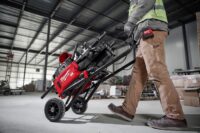https://vimeo.com/1020616812?share=copy Griggs Moody of Milwaukee Tool demos the MX Fuel Pipe Threading Machine at PHCC CONNECT Read more
tools
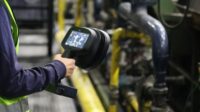
The other day I performed a Google search for ‘How to detect an air leak’. Not surprisingly it came up with millions of results, over 18 million in fact. Whether solving the problem in a commercial establishment or a domestic home environment, the majority of search results pointed to one solution. Namely, soapy water! Before Read more
The other day I performed a Google search for ‘How to detect an air leak’. Not surprisingly it came up with millions of results, over 18 million in fact.
Whether solving the problem in a commercial establishment or a domestic home environment, the majority of search results pointed to one solution. Namely, soapy water!
Before we all ridicule the idea as belonging to a bygone era, take a vehicle with a slow puncture to a tyre fitting depot and the chances are they remove the wheel and spin it in water to determine the leak. It’s a simple time proven method for determining leaks from pressurized systems.
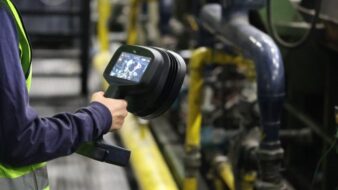 But of course, not all equipment can be placed in soapy water. What if a system is known to be losing pressure and yet the lines carrying the compressed air from the source are located 10 metres above the ground, and dismantling the system is out of the question? Thankfully there is a fast and effective solution to hand.
But of course, not all equipment can be placed in soapy water. What if a system is known to be losing pressure and yet the lines carrying the compressed air from the source are located 10 metres above the ground, and dismantling the system is out of the question? Thankfully there is a fast and effective solution to hand.
Each time air or indeed any gas, leaks from a pressured system there is an associated sound. If the leak is significant, it can be audible to the human ear and therefore easily identified and rectified accordingly. However, most leaks in high pressure systems are extremely small and are out of the range of a human ear.
Think about a pressured air system on a large factory delivering compressed air from a bank of compressors to various stages of production throughout the manufacturing process. The chances are there are hundreds if not thousands of connections in the form of joints, reducers, valves, elbows, condensers etc. Each of these has the potential to leak small amounts of air, reducing the pressure of the system.
One leak might make very little difference but multiply this by the number of potential leaking joints and efficiency can be significantly compromised. The compressor will seek to compensate for any pressure loss by simply working harder. However, as any engineer will know, compressors can be expensive to operate in terms of energy and therefore will certainly increase an operators energy consumption.
With electricity costs being so much higher in Europe due to geopolitical factors in recent years, most companies are seeking to reduce the amount of energy used. Having a compressor work overtime to compensate for leaking joints is certainly not something senior management would smile about!
These scenarios are certainly not uncommon, in fact one European compressor manufacturer has stated that in some industrial settings, up to 80% of air generated is lot in leaks. So clearly identifying these small leaks can make a real difference to a company’s energy bills.
Although the sound produced by a small leak is inaudible to the human ear a high performance acoustic imaging camera such as the FLIR Teledyne Si2 – LD will have absolutely no problem identifying the source. Launched earlier this year the camera is capable of detecting leaks of 0.05 litres per minute at a distance of 10 metres, meaning those elevated air lines pose no problem for this latest instrument in the FLIR acoustic imaging camera line up.
For closer work the camera is even more sensitive and can detects minute leaks of 0.0032 litres per minute at a distance of 2.5 metres. Coupled with this improvement, the third-generation camera has improved microphones now capable of detecting sounds over an extremely wide frequency range, namely 2 – 130 kHz.
Areas of plant are often dark or dimly lit. for this reason FLIR have fitted the FLIR Si2-series of cameras with two powerful LED lights to make component identification easy even in poorly lit conditions.
Of course, it’s not just compressed air that the camera is capable of detecting; noise emitted by any escaping gas is identified by the powerful microphones. However that’s only part of the story.
The FLIR Si2-LD has built in software termed Industrial Gas Quantification. If the leaking gas is ammonia, hydrogen, helium, or carbon dioxide, very commonly used gases in a number of industries, the software is capable of quantifying the financial loss caused by the leak. By simply entering factors such as the cost per litre, the software identifies the amount each leak is causing over a given period of time. Such data is invaluable to financial analysts and senior management within an organisation.
It goes without saying that the financial considerations are only one aspect of leaking gas. The gases mentioned above all carry significant health hazards and can present a variety of dangers to personnel if allowed to leak for any period of time. Ammonia and carbon dioxide can cause serious breathing problems and asphyxiation even in smaller concentrations, whereas hydrogen can explode in the presence of oxygen. Clearly the cost of such problems goes way beyond any financial considerations.
We’ve come a long way since the ‘soap and water’ approach. See how the latest technology from FLIR Teledyne can help in reducing downtime, lower energy bills and improve safety in your organisation.
Visit www.flir.com or contact you local FLIR Teledyne agent or distributor.
 Author: Darrell Taylor
Author: Darrell Taylor
Email: Darrell.Taylor@teledyne.com

https://vimeo.com/1017199033?share=copy This week we’ll talk soaring heat pump sales numbers, we unveil an eye-popping number that 43% of students surveyed said they would consider a skilled trade if they had more information, and Milwaukee Tool expands, and did you know where the best states are to live to be in the trades Read more
This week we’ll talk soaring heat pump sales numbers, we unveil an eye-popping number that 43% of students surveyed said they would consider a skilled trade if they had more information, and Milwaukee Tool expands, and did you know where the best states are to live to be in the trades?
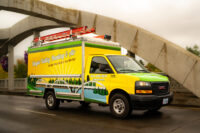
If you have always wanted to become a plumber then you may be wondering how to go about this. Plumbing is a wonderful career to get into as there will always be people with leaks or other issues that need to be fixed. However, it is not as simple as just going out into the Read more
If you have always wanted to become a plumber then you may be wondering how to go about this. Plumbing is a wonderful career to get into as there will always be people with leaks or other issues that need to be fixed. However, it is not as simple as just going out into the big wide world fixing peoples sinks and toilets. You will need to get the right level of education and experience if you want to create a successful plumbing business.
Get Educated
One of the first things you need to do if you want to run your own business is get educated. This means heading to college or taking an apprenticeship to get the right qualifications. When people are looking for a plumber to help them they will look at things like qualifications, paperwork, and experience. If you don’t have what they need then you may struggle to find work. It can sometimes be better to do an apprenticeship in plumbing and get into it that way, at least then you will gain valuable experience along the way.
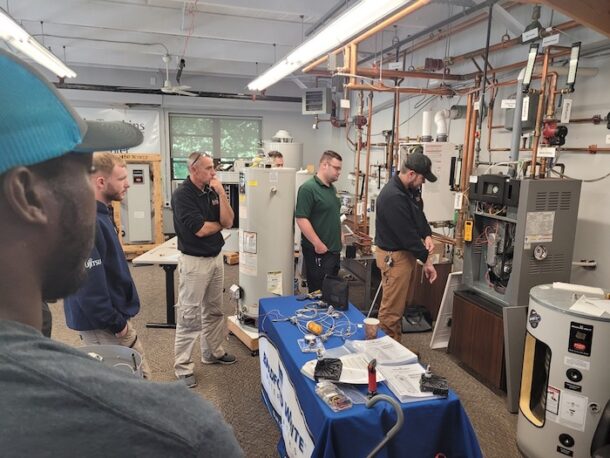
Licenses & Registration
Another thing you will need before you head off into the wide world of plumbing is the correct licenses and paperwork. You need to register to be a plumber and what you need will vary depending on your state. Make sure you know what you need at the last thing you want is to be missing something when you go to apply. Being registered means people will be able to find you easier and they can trust you have met all the minimum requirements.
Target Audience
Before becoming a plumber it can be useful to do some market research. This involves looking around your local areas to see if there is any need for plumbers. Great news, if there are that many around then you should get a great deal of customers and clients contacting you. You can find out whether there is any need for plumbers by sending out polls to potential customers. This can also be done on social media platforms, people can click yes or no depending on the questions you ask.
Funding
When you are about ready to open up your new plumbing business then you need to work out how much funding you need. This will provide you with everything you need, from tools to marketing, and everything in between. If you don’t have this money to hand then there are a couple of things you can do. You could apply for either a business loan or a credit card, as you won’t need high amounts like other businesses to get started.
Equipment
Finally, as a fully fledged plumber you will require the right tools and equipment. You will be dealing with many different nuts, bolts, and faucets during your work day. Kit yourself out with everything you need, you never know when you will need it. Brand new stuff can be expensive so don’t be afraid to buy second hand, used goods. As long as they are in full working order you can give them a new lease of life. When you are finished on jobs and you have taken pipes and other metals out then you could scrap it with scrap dealers near me.
We hope you found this article helpful and that it gave you some ideas, tips, and guidance on what you need to open and run a successful plumbing business.

Grenada, Miss. — Milwaukee Tool has, once again, expanded their presence in the United States with the opening of their newest manufacturing facility located in Grenada County, Mississippi. The new location will employ more than 800 people, marks Milwaukee’s eighth location in Mississippi, and is the company’s largest manufacturing facility in the United States to Read more
Grenada, Miss. — Milwaukee Tool has, once again, expanded their presence in the United States with the opening of their newest manufacturing facility located in Grenada County, Mississippi. The new location will employ more than 800 people, marks Milwaukee’s eighth location in Mississippi, and is the company’s largest manufacturing facility in the United States to date.

“Our rapid growth continues to accelerate, and this new facility in Grenada plays a crucial role in maintaining our trajectory of excellence in serving our distributor and user partners,” said Scott Griswold, Group President of the Professional Accessories Business Unit at Milwaukee Tool. “This success is the direct result of recruiting some of the best talent around the nation, especially in the state of Mississippi. Our strong people and our unique culture are unlike anything else in the industry.”
Milwaukee Tool invested more than $60 million into the more than 500,000-square-foot facility. Equipped with state-of-the-art technology and manufacturing capabilities, the Grenada location will initially produce Milwaukee’s robust line of accessories, including their legendary SAWZALL® Blades, and will expand into additional product lines over time.

Milwaukee Tool, celebrating its 100th anniversary this year, has seen remarkable double-digit growth every year for more than a decade. With a workforce of over 10,000 in the U.S. alone, the company has expanded its footprint both domestically and globally, driven by this consistent growth. In Mississippi, Milwaukee Tool has invested more than $250 million over the last five years and employs more than 4,000 people.

